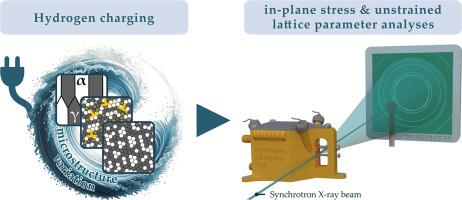微观组织变化对双相钢氢渗透的影响
IF 2.9
Q2 MATERIALS SCIENCE, MULTIDISCIPLINARY
引用次数: 0
摘要
氢脆在钢的应用中仍然是一个重大的挑战,其潜在的机制尚未完全了解。本研究考察了双相钢在4小时的电解充电过程中微观结构变化对氢吸收的影响。为了解决这个问题,研究人员分析了三种不同的微观组织状态:初始(粗晶)、高压扭转(HPT)加工状态和热处理HPT状态,其中氢渗透影响深度约为100 μ m。原位同步加速器x射线衍射显示,在纳米晶HPT加工样品中,奥氏体和铁素体的晶格参数扩展分别为0.015和0.003 Å。相比之下,初始(粗晶)样品显示奥氏体增加0.005 Å,而铁素体没有可检测到的变化。在纳米晶微观结构中,两相的晶格膨胀明显,同时奥氏体和铁素体的面内压缩应力分别增加了200 MPa和850 MPa。此外,热解吸光谱表明,在HPT加工状态下,氢的吸收率为16 ppm,比粗粒度状态高出4 ppm。随后的热处理将吸氢量降低到4ppm,使奥氏体晶格参数的变化减少了五倍,同时保留了处理后的HPT样品中观察到的铁素体响应。电镜分析表明,奥氏体和铁素体对充氢的不同响应归因于它们各自的微观结构特征。这些发现为双相钢中氢输运的微观组织控制提供了新的见解,对抗氢材料的设计和开发具有重要意义。本文章由计算机程序翻译,如有差异,请以英文原文为准。

Impact of microstructural variations on hydrogen permeation into duplex steel
Hydrogen embrittlement remains a significant challenge in steel applications with its underlying mechanisms still not fully understood. This study examines the influence of microstructural variations in duplex steel on hydrogen uptake during electrolytic charging over a duration of four hours. To address this, three distinct microstructural states are analyzed: initial (coarse-grained), high-pressure torsion (HPT) as-processed, and heat-treated HPT states, with hydrogen penetration affecting depths of approximately 100 µm. In-situ synchrotron cross-sectional X-ray micro-diffraction reveals that, in the nanocrystalline HPT as-processed sample, austenite and ferrite exhibit lattice parameter expansions of 0.015 and 0.003 Å, respectively. In contrast, the initial (coarse-grained) sample shows a 0.005 Å increase in austenite, while no detectable change is observed in ferrite. The pronounced lattice swelling in both phases of the nanocrystalline microstructure is accompanied by an increase in compressive in-plane stresses of 200 MPa in austenite and 850 MPa in ferrite. Furthermore, thermal desorption spectroscopy indicates a hydrogen uptake of 16 ppm in the HPT as-processed state, exceeding the coarse-grained condition by 4 ppm. Subsequent heat treatment reduces hydrogen uptake to 4 ppm, yielding a fivefold decrease in the variation of the austenite lattice parameter while preserving the ferrite response observed in the as-processed HPT sample. The distinct responses of austenite and ferrite to hydrogen charging are attributed to their respective microstructural characteristics, as revealed by electron microscopy analyses. These findings provide new insights into the microstructural control of hydrogen transport in duplex steels, with important implications for the design and development of hydrogen-resistant materials.
求助全文
通过发布文献求助,成功后即可免费获取论文全文。
去求助
来源期刊

Materialia
MATERIALS SCIENCE, MULTIDISCIPLINARY-
CiteScore
6.40
自引率
2.90%
发文量
345
审稿时长
36 days
期刊介绍:
Materialia is a multidisciplinary journal of materials science and engineering that publishes original peer-reviewed research articles. Articles in Materialia advance the understanding of the relationship between processing, structure, property, and function of materials.
Materialia publishes full-length research articles, review articles, and letters (short communications). In addition to receiving direct submissions, Materialia also accepts transfers from Acta Materialia, Inc. partner journals. Materialia offers authors the choice to publish on an open access model (with author fee), or on a subscription model (with no author fee).
 求助内容:
求助内容: 应助结果提醒方式:
应助结果提醒方式:


